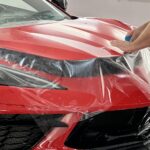When it comes to preserving your vehicle’s paint and appearance, there are several protective options available. Understanding the differences between wax, sealants, ceramic coatings, and paint protection film (PPF) is essential for making an informed choice. Each method offers unique benefits and drawbacks, making them suitable for different types of vehicles and owner needs.
Wax: Traditional Shine and Aesthetic Enhancement
Car wax, typically made from natural carnauba wax along with other blended polymers and oils, has been the go-to choice for enhancing a vehicle’s shine and providing a layer of protection. Waxing helps in protecting the paint from UV rays and moisture. It’s easy to apply and relatively inexpensive, making it popular among casual car owners who prefer a hands-on approach.
Pros: Enhances gloss significantly, affordable, good for regular maintenance. Cons: Least durable form of protection, typically lasts only a few weeks or months, requires frequent reapplication.
Sealants: Synthetic Protection with Durability
Automotive sealants are synthetic polymers that bond to the paint’s surface to offer a protective layer that lasts longer than traditional waxes. Sealants can stand up to the environment and chemical contaminants much better than wax, and they usually last for about six months.
Pros: Longer-lasting than wax, good chemical and UV resistance, enhances the paint’s appearance. Cons: Less natural gloss compared to wax, application can be more complex.
Ceramic Coatings: Advanced Chemical Protection
Ceramic coatings represent a significant advancement in protective products. Composed of silicon dioxide (SiO2), ceramic coatings create a hard, durable layer over the paint, offering protection against chemical stains, oxidation, UV exposure, and even minor abrasions. They also repel water and dirt, making the vehicle easier to clean.
Pros: Long-lasting (up to several years), excellent protection against environmental factors, adds depth and gloss to paint. Cons: High initial cost, professional application is recommended, curing time required.
Paint Protection Film (PPF): Ultimate Physical Barrier
PPF, or clear bra, is a thermoplastic urethane film applied to the exterior of a vehicle to protect it from physical damages such as stone chips, bug splatter, and minor abrasions. It is by far the most effective form of protection for maintaining a car’s exterior in pristine condition.
Pros: Provides physical barrier, self-healing properties, can last up to ten years, preserves resale value. Cons: Most expensive option, professional installation required.
Comparing Costs and Longevity
The cost of these protective measures varies widely. Wax is the cheapest and easiest to apply but offers the least durability. Sealants and ceramic coatings offer a middle ground, requiring more of an upfront investment but less frequent applications. PPF, while the most costly, offers the most comprehensive protection and is best for those looking to maintain their vehicle’s appearance over the long term without frequent reapplications.
Making the Right Choice
The best protective method depends on several factors, including your budget, the climate you live in, and how long you plan to keep your vehicle. For those who regularly change cars or those living in mild environments, wax or sealants might suffice. For car enthusiasts or those in harsh climates, ceramic coatings or PPF provide a more robust solution.
Conclusion
Whether you choose wax, sealants, ceramic coatings, or paint protection film, each option serves to enhance and protect your investment. By selecting the appropriate level of protection, you can keep your vehicle looking newer for longer, preserve its value, and enjoy a better driving experience.









